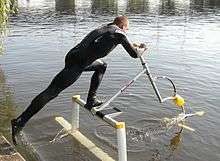Human-powered hydrofoil


A human-powered hydrofoil is a small hydrofoil watercraft propelled entirely by the muscle power of its operator(s).[1] Hydrofoils are the fastest water-based vehicles propelled solely by human power. They can reach speeds of up to 34 km/h (21 mph; 18 kn),[1][2][3] easily exceeding the world records set by competitive rowing which stand at about 20 km/h (12 mph; 11 kn). This speed advantage is achieved since hydrofoils lack a submerged body to provide buoyancy, greatly reducing the drag force.[1]
Propulsion
Means of propulsion include screw propellers, as in hydrocycles, aircraft propellers, as in the Decavitator, paddles, as in a Flyak, and flapping wings, as detailed below.
Flapping wing propulsion
Flapping wing propulsion devices are hydrofoils that generate propulsion by forcing a foil to move up and down in the water. The forward motion of the foil then generates lift as in other hydrofoils. A common design consists of a large foil at the stern that is used both for propulsion and keeping the passenger above the water, connected to a smaller foil at the bow used for steering and longitudinal stability. Riders operate the vehicle by bouncing up and down on a small platform at the stern, whilst holding onto a steering column.[4][5] It is started and landed from the shore, or preferably from a dock, and requires a bit of experience. When moving too slowly, it will sink, and the range of possible speeds is 9–30 km/h (5.6–18.6 mph; 4.9–16.2 kn)[5]
Several variations on the design have been developed:
- The Wasserläufer was a forerunner of the design developed in Germany during the 1950s.[6]
- The Flying Fish was developed by Allan Abbott and Alec Brooks in 1984 .[7]
- The Pogofoil, with pontoons for flotation, was developed in the US in 1989.[8]
- The Trampofoil was developed in Sweden in 1998.[9]
- The AquaSkipper was developed the US in 2003.[10][11]
- The Pumpabike was developed in South Africa in 2004.[5][12]
References
- 1 2 3 Graham-Rowe, Duncan (2005-05-23). "Human-powered hydrofoil seeks jumpy riders". New Scientist.
- ↑ "Pumpabike personal hydrofoil". Stuff.tv. 2005-12-17. Retrieved 2008-04-29.
- ↑ "Decavitator Human-Powered Hydrofoil". Retrieved 2013-02-10.
- ↑ "Suzi goes for a bit of pumping". Five - The Gadget Show. 2006-10-16. Retrieved 2008-04-29.
- 1 2 3 "Pumpabike: Human-Powered Hydrofoil". Gizmodo. 2005-05-24. Retrieved 2008-04-29.
- ↑ "1953 The "Wasserläufer"". Human-Powered Hydrofoils. Retrieved 2013-02-10.
- ↑ "1984 The "Flying Fish"". Alec Brooks and Allan Abbott. Retrieved 2013-12-31.
- ↑ "1989 Pogofoil Parker McCready". Human-Powered Hydrofoils. Retrieved 2013-02-10.
- ↑ "1998 Trampofoil". Human-Powered Hydrofoils. Retrieved 2013-02-10.
- ↑ "Aquaskipper". Uncrate. Retrieved 2013-02-10.
- ↑ "AquaSkipper". Human-Powered Hydrofoils. Retrieved 2013-02-10.
- ↑ "Pumpabike". Human-Powered Hydrofoils. Retrieved 2013-02-10.
External links
- human-powered-hydrofoils.com - Human powered hydrofoil designs from 1953 to present
- Instruction videos on how to use the trampofoil
| ||||||||||||||||||||||||||||||||||||||||||||||||||||||||||||
